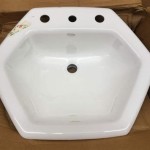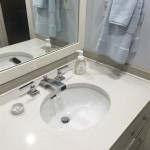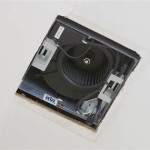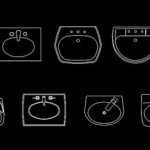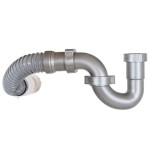Bathroom Sink Water Smells Weird: Identifying the Causes and Solutions
A persistent, unpleasant odor emanating from the bathroom sink drain is a common household issue that can cause significant frustration and concern. While the source of the smell might seem mysterious, understanding the potential culprits and implementing appropriate solutions can effectively resolve the problem. This article will delve into the various reasons why bathroom sink water might smell weird, exploring the contributing factors and providing detailed guidance on how to eliminate the odor at its source.
The problem of a smelly sink drain is rarely due to the water supply itself. Municipal water supplies are typically treated to remove contaminants and ensure potability. While temporary changes in water treatment processes or localized incidents can occasionally result in temporary odors, these instances are generally addressed quickly by the water authority. More frequently, the issue lies within the drainage system specific to the bathroom sink.
Biofilm Buildup: A Major Contributor
Biofilm, a slimy layer composed of bacteria, organic matter, and mineral deposits, is a primary cause of unpleasant smells originating from bathroom sink drains. This biofilm accumulates over time on the interior surfaces of the drainpipe, particularly in areas where water flow is restricted or where debris tends to collect. The bacteria within the biofilm thrive in the damp, dark environment and decompose organic material, releasing foul-smelling gases as a byproduct of their metabolic processes.
The types of organic matter that contribute to biofilm formation in bathroom sinks are varied. Hair, soap scum, toothpaste residue, skin cells, and other personal care products regularly find their way down the drain. These materials provide a readily available food source for the bacteria, accelerating biofilm growth and intensifying the odor. The design of the drainpipe, including bends and crevices, can also promote biofilm accumulation by creating areas where debris can become lodged.
To mitigate biofilm buildup, regular cleaning of the drain is crucial. This can be accomplished through several methods, including flushing the drain with hot water, using enzymatic drain cleaners, or physically scrubbing the interior of the drainpipe with a brush. Preventing debris from entering the drain in the first place by using drain screens and being mindful of what is rinsed down the sink can also significantly reduce biofilm formation.
Sewer Gas Leakage: A Serious Concern
Another potential source of a foul odor from the bathroom sink is sewer gas leakage. Sewer gas is a complex mixture of gases produced during the decomposition of organic waste in the sewage system. These gases, which can include methane, hydrogen sulfide, ammonia, and carbon dioxide, can have a distinctly unpleasant smell, often described as rotten eggs or sewage.
The primary barrier preventing sewer gas from entering the home is the P-trap, a U-shaped section of pipe located beneath the sink. The P-trap is designed to hold a small amount of water, creating a seal that prevents gases from flowing up the drainpipe and into the living space. If the P-trap is dry, damaged, or improperly installed, sewer gas can escape and cause a noticeable odor.
A dry P-trap can occur if the sink is not used frequently, allowing the water in the trap to evaporate. This is particularly common in guest bathrooms or infrequently used sinks. To remedy this, simply running water down the drain for a few minutes will refill the P-trap and reestablish the water seal. A damaged or improperly installed P-trap, however, may require professional plumbing services to repair or replace the faulty component.
Other potential causes of sewer gas leakage include cracks or leaks in the drainpipe, loose connections, or problems with the venting system. The venting system is a network of pipes that allows air to circulate in the plumbing system, preventing a vacuum from forming and ensuring proper drainage. If the venting system is blocked or malfunctioning, it can create pressure imbalances that force sewer gas into the home. Identifying and addressing these issues often requires the expertise of a qualified plumber.
Mineral Deposits and Corrosion: Less Common, But Possible
While less prevalent than biofilm or sewer gas leakage, mineral deposits and corrosion within the drainpipe can also contribute to unpleasant odors. Over time, hard water containing high levels of calcium and magnesium can deposit mineral scale on the interior surfaces of the drainpipe. This scale can trap debris and create a rough surface that promotes biofilm growth. Additionally, certain types of pipes, particularly older metal pipes, are susceptible to corrosion. Corrosion can release metallic odors and create crevices that harbor bacteria.
The presence of mineral deposits can be addressed through the use of descaling agents or by physically cleaning the drainpipe. Descaling agents, often containing acids or chelating agents, dissolve the mineral scale and restore the smooth surface of the pipe. Physical cleaning involves using a brush or other tool to scrub away the scale. In cases of severe corrosion, replacing the affected section of pipe may be necessary.
The type of pipe material can also influence the likelihood of mineral deposits and corrosion. PVC pipes are generally more resistant to corrosion and mineral buildup compared to metal pipes. If recurring problems with odors from the drain are observed, consider replacing older metal pipes with PVC alternatives.
Beyond the aforementioned common causes, some less frequent scenarios might lead to unusual smells emanating from the bathroom sink. These include the presence of a dead animal in the drainpipe, chemical reactions between different cleaning products, or even issues related to the plumbing fixtures themselves. A thorough inspection of the drain and plumbing system is often necessary to pinpoint the exact source of the odor in these atypical situations.
Proper maintenance and proactive measures can significantly reduce the likelihood of encountering unpleasant odors from the bathroom sink drain. Regular cleaning, using drain screens to prevent debris accumulation, and ensuring that the P-trap remains filled with water are all effective strategies for maintaining a clean and odor-free drain. When confronted with a persistent or particularly strong odor, consulting with a qualified plumber is recommended to diagnose the underlying cause and implement the appropriate solution.
Addressing the reason for a smelly bathroom sink requires a systematic approach. Firstly, attempt simple solutions like flushing with hot water or using a store-bought drain cleaner. If the problem persists, a more detailed investigation, potentially involving professional plumbing assistance, may be warranted. By understanding the common causes and employing appropriate preventative measures, it is possible to maintain a fresh and odor-free bathroom environment.

Moldy Smelling Water From Bathroom Faucet Hometalk

Your Household Water Quality Odors In Uga Cooperative Extension

How To Treat Smelly Water Finkens
What The Heck In This Ugly Black Stuff My Wife Has Been Complaining About A Nasty Smell Coming From Her Bathroom Sink Since We Moved Into Our New House Two Years Ago

Why Does My Water Smell Bad Flood Brothers Plumbing
How To Tell If Water Is Safe Drink Or Contaminated

Why Does My Water Smell And Stain Appliances

How To Clean A Stinky Sink Drain Home Repair Tutor

Why Does My Bathroom Tap Water Smell Or Taste Funny

Cloudy Smelly Or Discoloured Water Quality Help Thames


